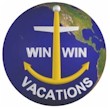Byzantium to Catalonia
Silversea cruise on the Silver Whisper
From Istanbul to Barcelona
April 28-May 12, 2002
|
April 28 Sunday |
Depart Seattle via British Airway for London |
|
April 29 Monday |
Arrive Istanbul from London BA 680 at 10:45pm |
The flights were uneventful and we arrived very tired. Our private transfer to The Ritz Carlton Hotel on April 29th was arranged by Lutfi Atay. It was so nice to see Lutfi there to meet us and not have to haggle with a taxi driver for a price and whatever else you’re supposed to do. Lutfi is an old friend and a guide to Istanbul. We had decided to splurge and stay at the Ritz Carlton. It was a good choice. We received a beautiful corner room with views of The Bosphorus and the Dolmabahce Palace. We were within walking distance of Taksim Square.
|
April 29 Monday
|
3 nights at the Ritz Carlton Hotel, Askerocagi
Caddesi, No. 15 • Elmadag / Sisli, 80200 • Istanbul, Turkey |
RITZ-CARLTON HOTEL ISTANBUL
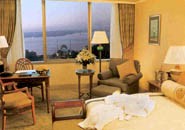 Since
October 2001 Istanbul added one more beautiful five star hotel to its already
impressive collection. The Ritz-Carlton Hotel Company opened a new property in
the middle of Istanbul's business and shopping district.
Since
October 2001 Istanbul added one more beautiful five star hotel to its already
impressive collection. The Ritz-Carlton Hotel Company opened a new property in
the middle of Istanbul's business and shopping district.
The hotel is situated in a modern building designed by Mr. Doruk Pamir, a famous Turkish architect. The interior decoration has been the responsibility of Mr. Sinan Kafadar. By using beautiful Turkish carpets, dark mahogany wood, and other luxurious fabrics Mr. Kafadar has successfully tried to bring a historical and intimate touch to this otherwise modern building.
The hotel counts a total of 244 guest rooms, including 21 executive suites, 1 Ritz-Carlton Suite, and 3 floors of Ritz-Carlton Club level rooms and suites. The Ballroom can seat up to 800 people in theatre style, or 300 people for a sit down dinner. There are 10 more function rooms of various sizes, available for break out sessions, board meetings and the like. The hotel has 2 a la Carte restaurants, which serve casual in- and out door dining. For the Ritz-Carlton tradition of Afternoon Tea, however, the lobby lounge is the place.
This hotel offers many nice features, but is probably most proud of its Spa & Fitness Center, which they claim to be The First Real Spa and Fitness Center in Istanbul. Whether correct or not, the Spa offers a wealth of therapies, treatments and simply enjoyment. Needless to say, a Turkish hamam is one of them….
From its
strategic Dolmabahce location overlooking the waters of The Bosphorus, the
famous straits that divide Europe and Asia, The Ritz-Carlton, Istanbul with its
dramatic contemporary design soars above the fabled city's landmark mosques and
centuries-old Palaces. 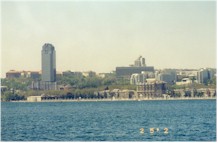 The hotel offers an atmosphere of privacy and refinement created through
the luxurious fabrics and unique works of art in the lobby and restaurants that
is carried through to the accommodations. The influences of Roman, Byzantine and
Ottoman periods of Turkey have been used to instill a distinctive ambience
allowing guests to submerge themselves in the rich history of the land. With a
balance of colors, a blending of beautiful woods, unique handmade Iznik tiles in
the bathrooms, spectacular views over Istanbul, Bosphorus, and the ancient
neighborhood of Sultanahmet, The Ritz-Carlton, Istanbul accommodations offer
guests the opportunity to experience the elegance of the Ottoman era within a
beautifully handcrafted Turkish décor created by the country's leading interior
decorator.
The hotel offers an atmosphere of privacy and refinement created through
the luxurious fabrics and unique works of art in the lobby and restaurants that
is carried through to the accommodations. The influences of Roman, Byzantine and
Ottoman periods of Turkey have been used to instill a distinctive ambience
allowing guests to submerge themselves in the rich history of the land. With a
balance of colors, a blending of beautiful woods, unique handmade Iznik tiles in
the bathrooms, spectacular views over Istanbul, Bosphorus, and the ancient
neighborhood of Sultanahmet, The Ritz-Carlton, Istanbul accommodations offer
guests the opportunity to experience the elegance of the Ottoman era within a
beautifully handcrafted Turkish décor created by the country's leading interior
decorator.
April 30 Tuesday -orientation tour - Topkapı Palace is closed on Tuesdays
- Grand Bazaar and Spice Bazaar are closed on Sundays
- St. Sophia Museum is closed on Mondays
- Museum of Turkish & Islamic Arts is closed on Mondays
Lutfi came for us at 10:00 am for our orientation walking tour of Istanbul. We started by walking up the hill from the Ritz Carlton to Taksim Square and continued down Istiklal Caddesi, the walking street of the “new” section of Istanbul called Beyoglu. Here we encountered a grand parade of shops, many churches and embassies that were turned into consulates when Ankara became the capital city of Turkey in 1923. We sidestepped through Cicek Pasaji, the former flower bazaar, turned into bars and small restaurants, and strolled through Balik Pazari, the fish market.
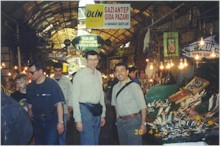 Tom
and Lutfi at the Fish Market. We observed lots of activity here and many
interesting wares for sale. Back on Istiklal Cad., we passed the Swedish
Consulate.
Tom
and Lutfi at the Fish Market. We observed lots of activity here and many
interesting wares for sale. Back on Istiklal Cad., we passed the Swedish
Consulate. 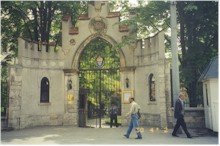
At Tunel Square, we took the cogwheel train to the bottom of the steep hill to Galata Bridge. Lutfi informed us that before the train was put in through the mountain, merchants had to push the wares up the steep hill from the Golden Horn to sell on the square above.
We wandered past
the New Mosque into the Egyptian Spice Market 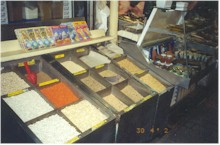 an
L-shaped market where you can also find household goods, toys and clothes. The
square between the 2 arms of the bazaar is full of stalls selling plants and
pets. This market is mainly for the local people to shop for their daily
necessities and prices are cheaper than at the Grand Bazaar, which mainly caters
to tourists, according to Lutfi. He treated us to some delicious baklava at a
small shop here. We were wondering about the blue thing for sale everywhere?
Lutfi explained it this way:
an
L-shaped market where you can also find household goods, toys and clothes. The
square between the 2 arms of the bazaar is full of stalls selling plants and
pets. This market is mainly for the local people to shop for their daily
necessities and prices are cheaper than at the Grand Bazaar, which mainly caters
to tourists, according to Lutfi. He treated us to some delicious baklava at a
small shop here. We were wondering about the blue thing for sale everywhere?
Lutfi explained it this way:
Protected? or just proud to be Turkish?
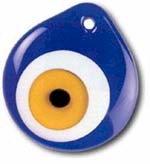 Whether
you are superstitious by nature or not, in Turkey there is no getting away from
'Nazar Boncuk', the famous blue bead that is believed to ward off evil power.
Let's say you are traveling to Turkey for a holiday. From the moment you get
into a taxi at the airport, Nazar is looking at you.....
Whether
you are superstitious by nature or not, in Turkey there is no getting away from
'Nazar Boncuk', the famous blue bead that is believed to ward off evil power.
Let's say you are traveling to Turkey for a holiday. From the moment you get
into a taxi at the airport, Nazar is looking at you.....
It may be dangling from the rear view mirror of the cab, or from the driver's key ring. It may be at the restaurant where you are going to taste your first kebab, or behind the reception of your hotel. You may even recognize it in some of the jewelry the ladies wear. This blue/white piece of glass, also called Nazar Boncuk, is as much a tradition as a superstition. Many people believe that wearing a Nazar Boncuk will protect them from the forces of the evil eye. However, it may also indicate that the wearer is Turkish and proud of it!
At the waterfront by the New Mosque is a tram stop where we got on and rode to the Blue Mosque, where we picked up the tickets for the Orient House dinner show that Lutfi had arranged for us. This is also the place to catch a ferry up The Bosphorus. After picking up the tickets, we went to the airport, driving along the ancient city walls and the outskirts of Istanbul to pick up Jan and Don Milligan, our friends from Bellevue, who would cruise with us.
Back at the hotel, we took a very short nap and decided to walk down to Dolmabahce Palace, which was closed for the day. We walked along the busy street along The Bosphorus all the way to the Galata Bridge.
 We observed people getting together for tea at the many cafes along the
way and also for a smoke of apple tobacco from very elaborate water pipes. We
walked up the steep hill to the Galata Tower, a distinctive silhouette 200 feet
high round tower with a conical roof built in 1348.
We observed people getting together for tea at the many cafes along the
way and also for a smoke of apple tobacco from very elaborate water pipes. We
walked up the steep hill to the Galata Tower, a distinctive silhouette 200 feet
high round tower with a conical roof built in 1348.
We had dinner at one of the small restaurants at the old flower market, where Lutfi had taken us this morning. Now it was crowded with people having tea and snacks. The waiters showed us all the different dishes and we picked several small appetizers to share. Then we quickly walked back to the hotel. At this time the street was crowded with people and full of activity. We were really tired from jetlag.
The Ritz Carlton offers heavenly, comfortable beds and sleep came quickly, but due to jetlag didn’t last long. What a drag!
May 1 Wednesday is open for exploring - Dolmabahce Palace is closed.
Lutfi says: "we have no holiday on May 1st and the day is like one of the usual days. All ferries and shops are open but be careful around Taksim Square, Grand Bazaar and Sultanahmet Square. It is safe but sometimes the extremist left side groups demonstrate on the main squares. There is no action aiming at tourists or local people. The only action is between the cops and the groups. Anyway, I suggest to be careful, perhaps some people will join the demonstration to protest against the Israeli government." We did not notice anything unusual or any demonstrations. At NO TIME did we feel insecure or threatened during our visit to Istanbul.
We took a taxi
to Topkapi Palace to save time. Topkapi was the residence of the Ottoman sultans
and the women of the harem for 400 years. It sits on the Seraglio Point where
the Marmara Sea meets the Bosphorus Straights and the Golden Horn. The fine art
collections, opulent rooms, 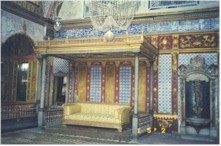
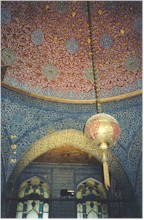 and leafy courtyards are among the highlights of a visit to Istanbul.
They double the entry fees on May first every year. We paid 15 million lire to
get in and 15 million more to see the Harem. Oh well, it was well worth it. You
can hire a guide offering their services at every turn, but we had a good
guidebook along and decided to go it alone. The Harem is always visited on a
guided tour. We headed over there and got our tickets and time. The wait was
short today. This is a must see.
and leafy courtyards are among the highlights of a visit to Istanbul.
They double the entry fees on May first every year. We paid 15 million lire to
get in and 15 million more to see the Harem. Oh well, it was well worth it. You
can hire a guide offering their services at every turn, but we had a good
guidebook along and decided to go it alone. The Harem is always visited on a
guided tour. We headed over there and got our tickets and time. The wait was
short today. This is a must see.
From a window
inside the Harem, we spotted the Silver Whisper.
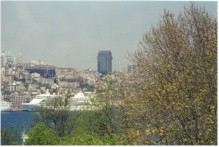 That's
the Ritz Carlton in the background (the tall black glass building).
That's
the Ritz Carlton in the background (the tall black glass building).
After spending many hours exploring the Topkapi Palace on a gloriously beautiful day, we stopped at Haghia Sophia church, an outstanding example of early Byzantine architecture and still one of the world’s most remarkable churches and more than 1400 years old.
Then we
proceeded to Sultanahmet, the Blue Mosque located opposite Haghia Sophia on
Sultanahmet Square. The Blue Mosque gets its name from the mainly blue iznik
tile work decorating its interior. 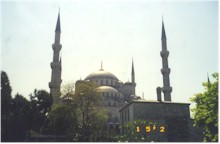 It’s a humble feeling entering this structure through the visitor’s
door and carrying ones shoes in a plastic bag. The magnificence and total beauty
is indescribable.
It’s a humble feeling entering this structure through the visitor’s
door and carrying ones shoes in a plastic bag. The magnificence and total beauty
is indescribable.
We wandered past
the Egyptian Obelisk of the ancient Hippodrome, which is all that is left of it
to the Grand Bazaar. Nothing could have prepared me for the thousands of small
shops and labyrinth of streets in this covered complex of cafes, restaurants,
carpet, jewelry and leather shops, banks and even a mosque, which can be found
inside the Grand Bazaar. 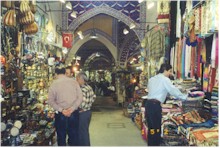 I
felt like I would never see daylight again! If you can’t find it here, it
doesn’t exist. Once, we found an exit gate we kept on going, walking downhill
to the Spice Market and crossing the Galata Bridge, where people were fishing.
We decided to climb to the top of the Galata Tower and were rewarded by a
magnificent panoramic view from the balcony surrounding the roof, of all of
Istanbul with it’s mosques and palaces and ships going up and down The Golden
Horn, The Bosphorus and the Marmara Sea. Again we spotted the Silver Whisper.
I
felt like I would never see daylight again! If you can’t find it here, it
doesn’t exist. Once, we found an exit gate we kept on going, walking downhill
to the Spice Market and crossing the Galata Bridge, where people were fishing.
We decided to climb to the top of the Galata Tower and were rewarded by a
magnificent panoramic view from the balcony surrounding the roof, of all of
Istanbul with it’s mosques and palaces and ships going up and down The Golden
Horn, The Bosphorus and the Marmara Sea. Again we spotted the Silver Whisper. 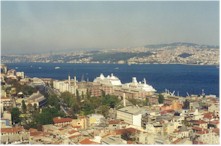
We decided to walk back to the hotel and take a nap before dinner and see if Jan and Don had recovered from their jetlag.
The dinner place
is called Orient House. They serve dinner and each of you will get 2 beers or
small bottle of vine or some other local drink with dinner. They display some
sample of Turkish folk dance show and different belly dancer perform belly
dancing as well. They will pick you up at hotel at 19:45. You will get a ride on
the way back to hotel. Orient restaurant is in Beyazit area. We enjoyed the
dinner and the belly dancing was absolutely outstanding. 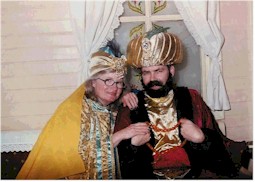 It was a very fun evening. By the looks
of this picture, we got carried away!
It was a very fun evening. By the looks
of this picture, we got carried away!
May 2nd Thursday, -guiding and minibus for a visit to the Asia side: Lutfi will pick us all up at 11:00 am and drop us off at the ship between 3-5:00 pm. Jan and Don are also going today. After a leisurely morning, we checked out of the Ritz and Lutfi picked us with his driver for our visit to the Asian side of Istanbul. We crossed the Bosphorus Bridge, a.k.a. Ataturk Bridge, completed in 1973 for the 50th anniversary of the Turkish Republic. It’s more than 5,000 feet long and 200 feet high.
We drove towards the Black Sea past many elegant villas, called Yalis. These served as summer residences of the grand viziers and other distinguished citizens of the Ottoman Empire.
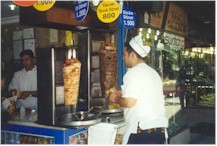 and
the Iskele Mosque, after enjoying a cup of Turkish coffee at a café along the
water looking across to Leander’s Tower on its own island and the Topkapi
Palace on the other side. The tiny white Leander’s Tower is a well-known
Bosphorus landmark, known in Turkish as the Maiden Tower. Lutfi told the
legend of the princess said to have been confined here after a prophet said
she would die of snakebite. Of course, the snake was hid in a basket of figs
that were brought to the princess and was able to administer the fatal bite to
her anyway.
and
the Iskele Mosque, after enjoying a cup of Turkish coffee at a café along the
water looking across to Leander’s Tower on its own island and the Topkapi
Palace on the other side. The tiny white Leander’s Tower is a well-known
Bosphorus landmark, known in Turkish as the Maiden Tower. Lutfi told the
legend of the princess said to have been confined here after a prophet said
she would die of snakebite. Of course, the snake was hid in a basket of figs
that were brought to the princess and was able to administer the fatal bite to
her anyway.
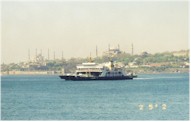 The
driver met us there and took us the ship. The check-in was painless, even
before we had our first glass of
Moet & Chandon champagne, which only took
seconds after boarding. We have
arrived on a once in a lifetime experience.
The
driver met us there and took us the ship. The check-in was painless, even
before we had our first glass of
Moet & Chandon champagne, which only took
seconds after boarding. We have
arrived on a once in a lifetime experience.
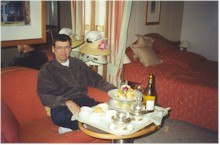 Caviar
and shrimp to hold us over 'til dinner.
Caviar
and shrimp to hold us over 'til dinner.
Kenneth Bach, Silversea Cruise Manager and April Yeandle, Cruise Consultant and Venetian Society Representative invited our group to a private cocktail party and dinner at the Terrace Cafe that first evening. The evening begins in the Le Champagne Bar with an introduction by the maitre d’ Rene Rasile, the Fine Dining Chef, of the menu in detail followed by the sommelier Leonardo de Vries and his description of the wines he has chosen to go with the meal. It's a set menu for dinner and every night is different. The service is impeccable. It’s just wonderful to be pampered.
Late night music and dancing is offered in the Bar and the Panorama Lounge.
What a sight, leaving Istanbul at nightfall, sailing out of The Bosphorus as the city lights up. I can’t describe it.
If I died and went to heaven, I must have been really good all my life! I pinch myself. Ouch, I'm still alive.
This is real. Life is good!
May 3, Friday |
Cruising the Aegean Sea |
This morning we
are cruising the Dardanelles, the narrow passage between the Aegean Sea and the
Sea of Marmara. It’s so beautiful today, not a cloud in the sky, just a wee
bit hazy. 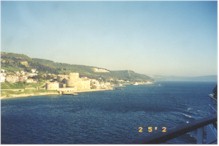 At
8:00 am we’re entering the Dardanelles
close to Galipoli. Captain Corsaro had intended to enter at 9:30
am, but because we were in front of a bigger than us, commercial ship
that needed to get through quicker, we had to speed up or anchor. Captain
Corsaro had a surprise in store for us this afternoon that he didn’t want to
miss, so he had to speed up. A couple of dolphins are playing right in front of
us for a short time, maybe 10 or so. This was the only time I saw any wildlife at
sea.
At
8:00 am we’re entering the Dardanelles
close to Galipoli. Captain Corsaro had intended to enter at 9:30
am, but because we were in front of a bigger than us, commercial ship
that needed to get through quicker, we had to speed up or anchor. Captain
Corsaro had a surprise in store for us this afternoon that he didn’t want to
miss, so he had to speed up. A couple of dolphins are playing right in front of
us for a short time, maybe 10 or so. This was the only time I saw any wildlife at
sea.
During the First World War there was a battle of Galipoli and many soldiers lost their lives here. First Lord of the Admiralty; Winston Churchill, searching for alternative theatres of operations and a more aggressive role for the British Navy, proposed a naval 'demonstration' using obsolescent battleships to force the straits of the Dardanelles and subdue Constantinople (present day Istanbul).
The straits of
the Dardanelles are a strategically vital waterway linking the Mediterranean,
through the Bosphorus at Constantinople, to the Black Sea ports of the great
rivers of heartland Russia and Eastern Europe. The Galipoli Peninsula forms a
natural gateway protecting the straits and their access to Constantinople.
Churchill's plan was based on the premise that Turkey would quickly surrender
once British warships stood off Constantinople. Turkey's defeat would present
many strategic rewards at little risk: it would assure the security of the Suez
Canal; the capture of the Dardanelles would open a warm-water supply route to
Russia; and a British victory would draw the unaligned Balkan nations into
supporting an Allied advance against the Central Powers, Germany and
Austria-Hungary; on a new southern front. Despite some reservations about the
plan and the imprecise nature of the objectives, the naval assault began on 19
February. Within a month it had failed utterly. The fleet was unable to overcome
the Turkish defensive minefields and concealed artillery batteries, which
protected the straits. One third of the Allied warships were sunk or disabled on
a single day, 18 March 1915. Many Australian and New Zealand troops called
Anzacs died that day. This is a special place for them. It is difficult to
understand that so much blood has been wasted in this small and beautiful area
in one single day. Today it seems so peaceful. 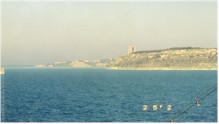
After sailing past Troy, we headed for Greece. It wasn’t very far. Some of the Greek islands are much closer to Turkey than to mainland Greece, which has been a source for controversy in the area. This brings me right to the next topic.
Special guest lecturer was Dr. Dieter Galler from Louisiana State University, my original Alma Mater. I spent 1 year there, when I first arrived from Sweden, studying French history and languages. The topic today: “Greece & Turkey, Can they co-exists in peace?” Dr. Galler is funny, knowledgeable and interesting to listen to. I almost remember one of his jokes:
“One way to make sure you’re flight is free of terrorists, is to hum the Iraqi national anthem as you board the plane and if anyone stands up and salutes, get off the plane immediately!” Something like that! We enjoyed his talks throughout the cruise.
We skipped the wine tasting and went to the Ballroom Dance class, where Brendon and James, the Gentlemen Hosts were teaching the Rumba. We learned a new variation. Then it was time for lunch. The dining room is elegant and the service impeccable, but …. The weather was so splendid; we opted for the buffet in the Terrace Café and choose a table outside in the aft. I live for these moments: To sit at the very aft of a luxury ship, with a glass of champagne, on a sunny day when I’m not cold and with a light warm breeze, calm seas, looking at the wake we make, barely noticeable, just a ripple of our "tracks", straight back in the deep blue sea! Life is Good!
There was always plenty of seafood and sushi to satisfy me. Wine is poured generously at each meal and it tends to make you a bit sleepy. We had no trouble finding a teak deck chair with a thick cushion and thick blue cotton towels by the pool to relax the afternoon away with a book and some shut-eye.
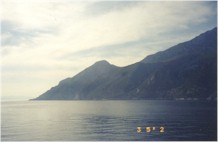 This was our surprise from the Captain, not on the itinerary. He
spoiled us this way a couple of more times during our cruise. This is a
rugged, pristine, unspoiled, most beautiful area of the world I have seen. Mt.
Athos is located in the entire third, eastern and most beautiful peninsula of
the prefecture of Chalkidike, which belongs to Macedonia, which in turn is
found in Northern Greece. It stretches as a long thin finger into the Aegean
Sea to a length of approximately 57 kilometers, being between 7 and 10
kilometers wide and having an area of 389 square kilometers. Inaccessible
mountain crests, thickly wooded slopes that plunge down into the deep sea,
secluded coves, rocky headlands, broad bays fringed by sandy beaches and
buildings of former centuries form one of the most beautiful landscapes in the
world.
This was our surprise from the Captain, not on the itinerary. He
spoiled us this way a couple of more times during our cruise. This is a
rugged, pristine, unspoiled, most beautiful area of the world I have seen. Mt.
Athos is located in the entire third, eastern and most beautiful peninsula of
the prefecture of Chalkidike, which belongs to Macedonia, which in turn is
found in Northern Greece. It stretches as a long thin finger into the Aegean
Sea to a length of approximately 57 kilometers, being between 7 and 10
kilometers wide and having an area of 389 square kilometers. Inaccessible
mountain crests, thickly wooded slopes that plunge down into the deep sea,
secluded coves, rocky headlands, broad bays fringed by sandy beaches and
buildings of former centuries form one of the most beautiful landscapes in the
world. 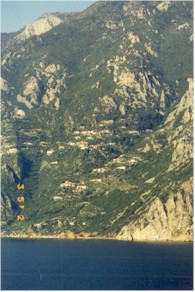 It
is the only place in Greece that is completely dedicated to prayer and worship
of God. For this reason, it is called the Holy Mount. Only bearded monks are
allowed here. The natural beauty of the peninsula is extraordinary. Mount
Athos is a huge cone of 2.033 meters in height. It’s a naked, treeless crest
that seems to lance the sky and its slopes are fully covered by ancient
evergreens. The area is cut off from the outside world.
It
is the only place in Greece that is completely dedicated to prayer and worship
of God. For this reason, it is called the Holy Mount. Only bearded monks are
allowed here. The natural beauty of the peninsula is extraordinary. Mount
Athos is a huge cone of 2.033 meters in height. It’s a naked, treeless crest
that seems to lance the sky and its slopes are fully covered by ancient
evergreens. The area is cut off from the outside world. 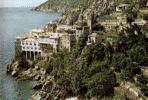 Monastery
on the Athos Peninsula. The
area has been divided into twenty self- governed territories. Each territory
consists of a monastery with its cloisters, cells, cottages, seats, and
hermitages. All the monasteries are communes, which means that there is common
liturgy, prayer, housing, nourishing and work among the monks. The Superior of
the monastery is elected by the monks for life and is responsible for the
affairs of the monastery. To come face to face with God, in the special way
that a monk is called upon, he needs solitude and quiet, with no external
distractions. Monks that need this special solitude do not live in communes,
but in solitary isolation as hermits. Mount Athos has the largest collection
of Christian art in the world. Almost all buildings were constructed thanks to
the ministrations of the Byzantine Emperors. The monasteries and their
foundations were endowed with works of art which can only be described as
masterpieces.
Monastery
on the Athos Peninsula. The
area has been divided into twenty self- governed territories. Each territory
consists of a monastery with its cloisters, cells, cottages, seats, and
hermitages. All the monasteries are communes, which means that there is common
liturgy, prayer, housing, nourishing and work among the monks. The Superior of
the monastery is elected by the monks for life and is responsible for the
affairs of the monastery. To come face to face with God, in the special way
that a monk is called upon, he needs solitude and quiet, with no external
distractions. Monks that need this special solitude do not live in communes,
but in solitary isolation as hermits. Mount Athos has the largest collection
of Christian art in the world. Almost all buildings were constructed thanks to
the ministrations of the Byzantine Emperors. The monasteries and their
foundations were endowed with works of art which can only be described as
masterpieces.
We cruised the area for an hour and luckily it was on our side of the ship, so I was able to get ready at the same time.
At 6:45 this evening, Captain Angelo Corsaro is hosting the Welcome Aboard Cocktail party in the Viennese Lounge. This is also the show lounge, beautifully and comfortably arranged with ample seating for everyone and lot’s of room. For dinner we’re having Sevruga Caviar and fresh Maine Lobster. Life is Good!
The evening
performance by the sensational Jean Ann Ryan Production Team is called “La
Belle Epoque”. The main dancers, Wendy Ann Mason and David Gouldie are from
South Africa. After that, we were too
tired to go dancing, or was it the wine that made us sleepy?
May
4, Saturday
|
Mykonos, Greece 8:00 am – 6:00 pm |
The
arid, rocky island of Mykonos is the most easterly of the northern Cyclades. 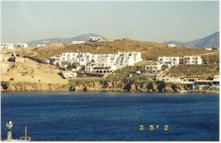 At one time it was one of the most important trading centers in the
western Aegean. Its many captivating attributes make it appear as if it came
straight off a tourism poster; it is one of the most celebrated Greek holiday
islands (along with Santorini that we visited last time).
At one time it was one of the most important trading centers in the
western Aegean. Its many captivating attributes make it appear as if it came
straight off a tourism poster; it is one of the most celebrated Greek holiday
islands (along with Santorini that we visited last time). 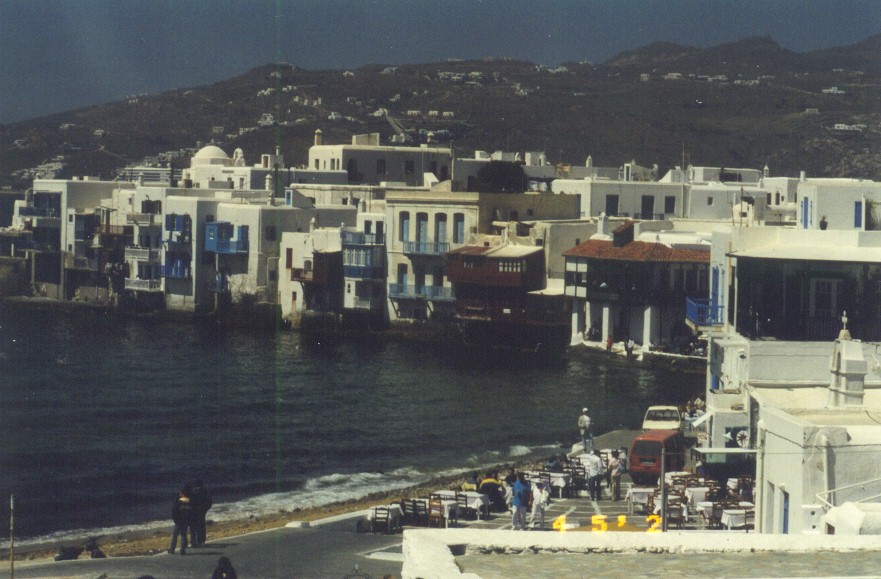 Its main village of the same name as the island is a colorful maze of
narrow, paved streets lined with white-washed houses with bright blue, red or
yellow doors and shutters. During the 1960s, the bohemian jet set discovered
Mykonos; many old houses along the waterfront are now restaurants, bars and
discos. Its harbor is a preferred anchorage for international yachtsmen. The
tiny town of cube-shaped houses extends in a semi-circle around the bay. As an
attractive backdrop, the famous windmills are lined up like toy soldiers on the
hillside, vestiges of a time when wind power was used to grind the island's
grain. Mykonos has some 365 churches and chapels scattered about the island;
quite a number of them are located right in town. Radiant flowers spill over
white-washed walls and shady courtyards. In addition to swimming, sunning,
water-skiing and surfing, visitors find endless shopping opportunities. Artists
have relied on Mykonos’ beautiful setting to inspire them.
Its main village of the same name as the island is a colorful maze of
narrow, paved streets lined with white-washed houses with bright blue, red or
yellow doors and shutters. During the 1960s, the bohemian jet set discovered
Mykonos; many old houses along the waterfront are now restaurants, bars and
discos. Its harbor is a preferred anchorage for international yachtsmen. The
tiny town of cube-shaped houses extends in a semi-circle around the bay. As an
attractive backdrop, the famous windmills are lined up like toy soldiers on the
hillside, vestiges of a time when wind power was used to grind the island's
grain. Mykonos has some 365 churches and chapels scattered about the island;
quite a number of them are located right in town. Radiant flowers spill over
white-washed walls and shady courtyards. In addition to swimming, sunning,
water-skiing and surfing, visitors find endless shopping opportunities. Artists
have relied on Mykonos’ beautiful setting to inspire them.
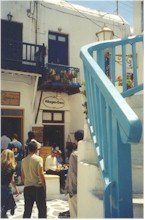 This
enchanting place no doubt is one of my favorites on any cruise holiday.
This
enchanting place no doubt is one of my favorites on any cruise holiday.
Our
Shore Excursion:
The island of
Delos
is visited for its archaeological site; exploration is entirely on foot. The
walking tour is about two hours; some of it is on uneven ground. We recommend
wearing flat, sturdy shoes. There is little shade; you may want to bring a sun
hat and sunscreen.
It’s
a gloriously sunny day, but it’s always windy in the Greek Islands and today
is no exception. Our guide met us as we stepped off the ship and took us for a
short bus ride to the ferry, which took us to the Sacred Island of Delos, at one
time the political and religious center of the Aegean.
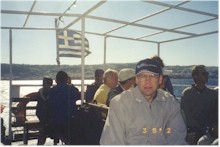 Ferry
from Mykonos to Delos.
Ferry
from Mykonos to Delos.
I
was very impressed and pleased to see everything I had studied in my Latin
classes 35 years ago. Lots to see here. Delos was the most
important Panhellenic sanctuary, and, according to mythology, the birthplace of
Apollo and Artemis. The declaration of Delos as an "international"
harbor by the Romans led to an influx of foreigners who became a significant
element of the island's population. The absence of taxes resulted to the
concentration of trade activity on the island and subsequently, to its economic
prosperity. Delos was a sacred place with splendid buildings and sanctuaries and
as such, it was never forgotten. The
wildflowers 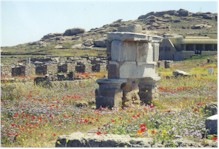 were
incredible in fields of purple, red and yellow.
were
incredible in fields of purple, red and yellow.
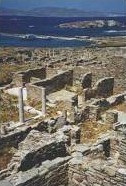 Excavations
on Delos started in 1873 by the French School of Archaeology at Athens. They
still have their ugly square houses sitting around. Intensive excavations were
conducted in the years 1958-1975. In 1990 Delos was included in the World's
Cultural Heritage, protected by the UNESCO.
Excavations
on Delos started in 1873 by the French School of Archaeology at Athens. They
still have their ugly square houses sitting around. Intensive excavations were
conducted in the years 1958-1975. In 1990 Delos was included in the World's
Cultural Heritage, protected by the UNESCO.
The most important monuments of the site are: The Agora of the Competaliasts, The Temple of the Delians, The Minoan Fountain, Terrace of the Lions, The Establishment of the Poseidoniasts from Beirut, The Stoivadeion, The Theatre, Temple of Isis, The Temple of Hera, The "House of Dionysos", The "House of Dolphins", The "House of Trident", and The "House of Masks".
Delos has an interesting archeological museum with lots to see, among them some very erotic statues. Six rooms contain the statues and reliefs found in Delos, one of the best collections in the world.
We stayed behind
when our tour was returning to Mykonos and climbed to the top of Mt. Kythnos. 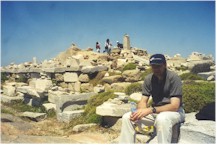
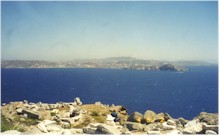
From here we could see many of the Cyclades islands: Mykonos, Tinos, Syros, Paros , Naxos and of course Big Delos, Riuea. It was on Big Delos that the women and children lived, where the hospitals were located, etc. after the purifications that took place on Delos to keep it “holy”. There was a land bridge across to Big Delos, the remains of which is still visible at both ends. On our way back to the harbor, we visited the Dolphin House, which got it’s name from the beautifully preserved dolphins on the floor mosaic.
We also stopped
at the House of Masks, the Greek Theatre, and at
Cleopatra’s House. 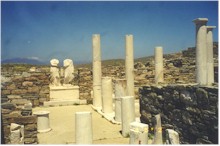 The
return on the ferry to Mykonos was
very windy. Mykonos is famous world-wide for its
chalk-white beauty and its vibrant night life. We walked up and down the narrow
streets, admiring the white square houses with blue balconies and flower
baskets. We decided to walk the 2 miles back to the ship, since the weather was
so gorgeous. The wind was a bit too strong,
blowing sand actually hurt a bit.
The
return on the ferry to Mykonos was
very windy. Mykonos is famous world-wide for its
chalk-white beauty and its vibrant night life. We walked up and down the narrow
streets, admiring the white square houses with blue balconies and flower
baskets. We decided to walk the 2 miles back to the ship, since the weather was
so gorgeous. The wind was a bit too strong,
blowing sand actually hurt a bit.
We sailed at 6:00 pm past Tinos and Syros. I love the Greek Islands and would love to spend more time exploring here.
 Bertie
Pierce, a comedian, magician and ventriloquist, tonight presents the
entertainment in the Viennese Lounge. Then off to some after dinner
and show dancing in the Bar and the Panorama Lounge. We requested that the
Silver Whisper Quintet play a Viennese waltz and polka for us. This became a
nightly event to our delight. They never did figure out how to play a shottis
or a hambo, however.
Bertie
Pierce, a comedian, magician and ventriloquist, tonight presents the
entertainment in the Viennese Lounge. Then off to some after dinner
and show dancing in the Bar and the Panorama Lounge. We requested that the
Silver Whisper Quintet play a Viennese waltz and polka for us. This became a
nightly event to our delight. They never did figure out how to play a shottis
or a hambo, however.
May
5, Sunday
|
Cruising the Ionian Sea, Another wonderful day at sea! |
Life is Good!
I love these days at sea. I always think “ How Wonderful! Nothing to do!” It never works out that way, believe me. There is always too much to do. This is such a great ship for days at sea, I like to do an ocean crossing with her one day. Again, we’re so lucky to have beautiful weather and calm seas. First of all, Tom Ogg requires my presence at 9:00 am at the NACTA seminar, which is why I’m on this cruise. I’m looking forward to hear his ideas and suggestions for a successful business plan. I’m also eager to network with the other agents onboard. My business has been very slow since September 11, also due to the Internet and the airline commission cuts, I’m sure. Tom Ogg presents a very informative seminar and I learn a lot of new ideas to try. Silversea is treating us very well and made their small conference room available to us. Ken, April and Captain Corsaro also addressed us. After the seminar, we had lunch outside at the Terrace Café, at my favorite table in the aft, overlooking the Ionian Sea, where the Silver Whisper made a small and straight trail in the water. Today is the Seafood Buffet, my favorite. As always: Life is Good!
Lunch is also offered in the dining room and the Pool Grill, but we never had lunch there. The Terrace Café was my favorite and we also had lunch on shore when on excursion.
Unfortunately, we missed the ballroom dance class today. It’s offered only on sea days.
This was my opportunity to really
get to know this ship in every detail before the visit to the Bridge. 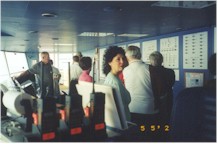 I always take pleasure in being invited by the captain to visit his
domain and see what he does and how it’s done. Captain Corsaro is very
friendly and always available to us as is his entire staff. The Silver Whisper
is very well run ship. We enjoyed the Bridge tour.
I always take pleasure in being invited by the captain to visit his
domain and see what he does and how it’s done. Captain Corsaro is very
friendly and always available to us as is his entire staff. The Silver Whisper
is very well run ship. We enjoyed the Bridge tour.
There are 3 bars on the Silver Whisper, including the Grappa bar. It’s a small intimate place that stays open after the main bar closes at night. There is a casino, but I never went there. It’s fairly small and seemed to be popular at night. I heard it paid out generously. The Humidor is located adjacent to the Champagne bar. Here you can pour yourself your favorite brandy from the cart and enjoy a Davidoff cigar. There is a Library and Internet Café, a favorite place that always seemed to be busy. Everybody gets his or her own personal email address while onboard. Receiving and sending email is very reasonable. I paid $1.50-2.00 for most transactions. There are Internet connections and a small fee is charged for surfing the net. It’s very inexpensive.
On deck 10, at the very top of the ship is the observation lounge with a small library and self serve coffee bar. This lounge is practically connected to the exercise room, a small dark room that I didn’t feel like using. Duh! I’m on a cruise.
Then there is the Mandara Spa from Bali. I wanted to try the hot stone massage therapy, but couldn’t get a time. The spa is very popular, so make reservations early. There is also a very nice beauty salon up here.
There are 2 shops onboard, the Boutique selling upscale jewelry and logo wear and a Bvlgary signature shop. Tom bought me a nice hat here.
There are self serve laundry facilities on several decks, but I forgot to peak in there. I sent Tom’s white sweater to the dry cleaning service after an unfortunate encounter with some red wine. Looked like the sweater had the measles! The cost was only $4.00 and all the stains were gone. Tom Ogg cruises often, and he brings his tux from the previous cruise and has it cleaned for the current cruise as soon as he gets onboard. Then it’s always clean and fresh. What a great tip, thanks Tom.
I have a concern about smoking: it is allowed in the Humidor, and at certain areas in the bar, the Panorama Lounge and the Viennese Lounge. The restaurants are smoke free. When we opened the veranda door in our cabin, we often had stale air with heavy smoke drawn into our cabin, which disappeared when we closed the glass doors. This was not good, as I love to have the veranda door open and enjoy the sound and smell of the sea and the fresh air. I mentioned it to Monica, but all she could do was offer to bring a fresh air spray. I heard that other people had the same problem in their cabins.
We had dinner in the dining room with
Jan and Don 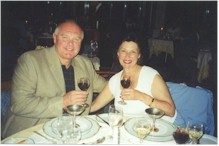 Carole
and Tony
Carole
and Tony 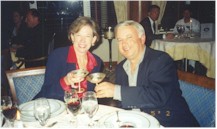 who
we met on the ship and enjoyed spending time with every day. If you want caviar
and it’s not on the menu, order it anyway and it appears for you. Rex, our
waiter, whose table we usually asked for because we liked him so well, always
found a wine to our liking. And we always liked different wines from each other.
He often had 6 bottles going for us and kept track of who liked what. He was
great. This evening, our cruise Director Ray Solaire,
puppet master extraordinaire, puts on a very interesting show with his puppets.
He dresses like the background and becomes invisible, so the puppets look very
much alive. Clever!
who
we met on the ship and enjoyed spending time with every day. If you want caviar
and it’s not on the menu, order it anyway and it appears for you. Rex, our
waiter, whose table we usually asked for because we liked him so well, always
found a wine to our liking. And we always liked different wines from each other.
He often had 6 bottles going for us and kept track of who liked what. He was
great. This evening, our cruise Director Ray Solaire,
puppet master extraordinaire, puts on a very interesting show with his puppets.
He dresses like the background and becomes invisible, so the puppets look very
much alive. Clever!
After dancing, we slept very well again that night. Life is good.
May
6, Monday
|
Catania (Sicily), Italy 8:00 am – 6:00 pm |
Sicily’s
second largest town after Palermo lies at the foot of Europe’s most famous
active volcano. The prominent cone of Mount Etna reaches almost 11,000 feet, its
slopes covered by hardened lava and scores of cones and craters - tangible
evidence of its ever-threatening presence.
At first sight, Catania does not seem overly impressive, but a closer look
reveals one of Sicily’s most intriguing and vibrant cities. Settled by Greek
colonists as early as 729 B.C., Catania became so influential that their laws
were eventually adopted by all the Ionian colonies of ancient Greece. During the
Roman occupation Catania grew into one of the largest towns in Sicily. Some of
its importance diminished in the early medieval period, but prosperity
flourished anew under Aragonese rule in the 14th century.
Destroyed several times by the eruptions of Mount Etna, many of Catania's
attractive buildings date from the reconstruction that followed a devastating
earthquake in 1693. It was the design of architect Giovanni Vaccarini that gave
the city its lofty, noble look. One of Catania's most handsome squares is the
Piazza del Duomo. In its center stands a fountain bearing the city’s symbol,
an elephant carved from lava and bearing a granite obelisk. The square is
surrounded by fine baroque structures and dominated by the 18th-century
cathedral. Granite columns from Catania's Roman amphitheater are incorporated in
the church's structure. Inside lies the tomb of the city's famous native son,
composer Vincenzo Bellini (1801-1835).
Closer to the seaside stands the Castello Ursino, which was built for Frederick
II about 1240. In the 14th century the castle became the residence of the kings
of Aragon. Thereafter, it served as a prison and since 1934 has housed the Civic
Museum. The city's main street, Via Etna, runs north for two miles, interrupted
by a series of spacious squares and Mount Etna as an imposing backdrop.
Shore
Excursions:
Syracuse.
Exploring the archaeological site requires extensive walking, some on steep,
uneven ground. We recommend wearing comfortable walking shoes and wearing a sun
hat. The price of the tour is based on keeping the group small for the walking
part: Neapolis, Syracuse - Ortygia. 8.5 hours
The
most rewarding excursions from Catania, may
be to the storybook village of Taormina, or
Syracuse or up the slopes of Mount Etna. We did the Taormina &
Castelmola excursion when we came last October, so we choose to travel
thirty-seven miles south to Syracuse, site of one of Sicily's most important
archaeological remains of its splendid past. I’m so glad we did. Again, I got
to re-live what I had studied in college back in Sweden in my Latin classes.
Our
excellent guide was Nunzio.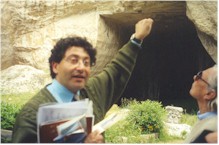 He was so enthusiastic and just LOVED telling us about Syracuse. He
talked all the way in the bus and I just ate it all up. He noticed and it made
him even more enthusiastic. He was wonderful. Silversea gets the best guides.
First we stopped at the old lime stone quarry with its caves.
Founded by the Corinthians in 733 BC, Syracuse was the richest
Greek city in Sicily primarily because of its shipping position. The Island of
Ortygia was the heart of the colony. Beyond Ortygia, in the Archeological Park
of Neapolis, are the limestone quarries, and what is known today as Paradiso
with the Ear of Dionysius, a cave carved from limestone.
He was so enthusiastic and just LOVED telling us about Syracuse. He
talked all the way in the bus and I just ate it all up. He noticed and it made
him even more enthusiastic. He was wonderful. Silversea gets the best guides.
First we stopped at the old lime stone quarry with its caves.
Founded by the Corinthians in 733 BC, Syracuse was the richest
Greek city in Sicily primarily because of its shipping position. The Island of
Ortygia was the heart of the colony. Beyond Ortygia, in the Archeological Park
of Neapolis, are the limestone quarries, and what is known today as Paradiso
with the Ear of Dionysius, a cave carved from limestone. 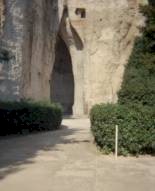 Dionysius
Ear. It has incredible acoustics, and we had fun listening to our echoes,
magnified 16 times. There were singers in there and children on school outings,
yelling and laughing.
Dionysius
Ear. It has incredible acoustics, and we had fun listening to our echoes,
magnified 16 times. There were singers in there and children on school outings,
yelling and laughing.
Remains of both
Greek (472 BC) and Roman theaters survive. 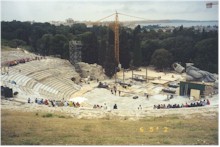 The caves of the Greek theater and half of the Roman amphitheater were
carved from the bedrock. This is the 3rd largest Grecian theatre on
earth after Ephesus and Megalopolis. A fascinating summer season of ancient
plays is still presented here each year. They were getting ready for the annual
play and were building the stage and seats, very carefully as to protect the
limestone. This year it’s going to be about how Prometheus stole the fire from
Zeus. Prometheus was punished for his theft of fire by being bound and having
his liver pecked out by an eagle. Five
tombs of the ancient Sicles have been uncovered in the area of the Greek
theater. The artifacts from these tombs are on display in the Regional Paolo
Orsi Archeological Museum. This excellent museum chronologically traces the
history of Sicily from prehistoric times to the Magna Graecia. We did not have
time to visit this excellent museum. At the Roman amphitheater is an altar,
where 450 cattle would be sacrificed at one time. We drove to Old Syracuse on
the island of Ortygia.
The caves of the Greek theater and half of the Roman amphitheater were
carved from the bedrock. This is the 3rd largest Grecian theatre on
earth after Ephesus and Megalopolis. A fascinating summer season of ancient
plays is still presented here each year. They were getting ready for the annual
play and were building the stage and seats, very carefully as to protect the
limestone. This year it’s going to be about how Prometheus stole the fire from
Zeus. Prometheus was punished for his theft of fire by being bound and having
his liver pecked out by an eagle. Five
tombs of the ancient Sicles have been uncovered in the area of the Greek
theater. The artifacts from these tombs are on display in the Regional Paolo
Orsi Archeological Museum. This excellent museum chronologically traces the
history of Sicily from prehistoric times to the Magna Graecia. We did not have
time to visit this excellent museum. At the Roman amphitheater is an altar,
where 450 cattle would be sacrificed at one time. We drove to Old Syracuse on
the island of Ortygia.
In the course of the 5th century B.C. the wealth, cultural development, and political power of Syracuse rivaled Athens itself. Syracuse continued to better the Carthaginians in battle and in the 3rd century B.C. became allied with Rome. Later the city attempted to reject the alliance and at ca. 212 B.C., after a two-year siege, the Romans conquered Syracuse. The Roman plunder and looting of art from Syracuse is said to have created the first appreciation of Classical Greek art in Rome. Syracuse declined under Roman rule and was finally destroyed by the Saracens in A.D. 878.
We walked
through the archway 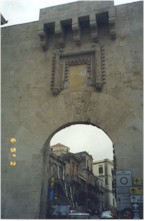 and visited Archimedes
Square. He was born in 287 BC in Syracuse, Sicily, and died: 212 BC in Syracuse,
Sicily. Archimedes, the greatest mathematician of antiquity, made his greatest
contributions in geometry. His methods anticipated the integral calculus 2,000
years before Newton and Leibniz. Stories from Plutarch, Livy, and others
describe machines invented by Archimedes for the defense of Syracuse. These
include the catapult, the compound pulley and a burning-mirror. The
achievements of Archimedes are quite outstanding. He is considered by most
historians of mathematics as one of the greatest mathematicians of all time. Archimedes
was killed during the capture of Syracuse by the Romans in the Second Punic War.
Plutarch recounts this story of his killing: As fate would have it, Archimedes
was intent on working out some problem by a diagram, and having fixed both his
mind and eyes upon the subject of his speculation, he did not notice the entry
of the Romans nor that the city was taken. A soldier unexpectedly came up to him
and commanded that he accompany him. When he declined to do this before he had
finished his problem, the enraged soldier drew his sword and ran it through him
as Archimedes shouted “Don’t disturb my angles”. He rarely if ever spoke
to anyone.
and visited Archimedes
Square. He was born in 287 BC in Syracuse, Sicily, and died: 212 BC in Syracuse,
Sicily. Archimedes, the greatest mathematician of antiquity, made his greatest
contributions in geometry. His methods anticipated the integral calculus 2,000
years before Newton and Leibniz. Stories from Plutarch, Livy, and others
describe machines invented by Archimedes for the defense of Syracuse. These
include the catapult, the compound pulley and a burning-mirror. The
achievements of Archimedes are quite outstanding. He is considered by most
historians of mathematics as one of the greatest mathematicians of all time. Archimedes
was killed during the capture of Syracuse by the Romans in the Second Punic War.
Plutarch recounts this story of his killing: As fate would have it, Archimedes
was intent on working out some problem by a diagram, and having fixed both his
mind and eyes upon the subject of his speculation, he did not notice the entry
of the Romans nor that the city was taken. A soldier unexpectedly came up to him
and commanded that he accompany him. When he declined to do this before he had
finished his problem, the enraged soldier drew his sword and ran it through him
as Archimedes shouted “Don’t disturb my angles”. He rarely if ever spoke
to anyone.
We then
proceeded to the cathedral, 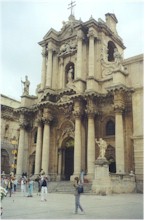 built on the ruins of an ancient
temple of Minerva (Athena) with thirty-six columns of which only twenty-two
remain. What a great surprise for me: This is where Santa Lucia was
born, I had totally forgot about that. And this was the week, except on December
13, that they bring her out of the locked cabinet to celebrate her. She was
standing there on the altar of the cathedral, a beautifully ornate silver
statue. The Italian Santa Lucia (d.
304, Syracuse, Sicily; feast day December 13) was a virgin and martyr who was
one of the earliest Christian saints to achieve popularity, having a widespread
following before the 5th century. She is the patron saint of the city of
Syracuse in Sicily. Because of various traditions associating her name with
light, she came to be thought of as the patron of sight and was depicted by
medieval artists carrying a dish containing her eyes.
built on the ruins of an ancient
temple of Minerva (Athena) with thirty-six columns of which only twenty-two
remain. What a great surprise for me: This is where Santa Lucia was
born, I had totally forgot about that. And this was the week, except on December
13, that they bring her out of the locked cabinet to celebrate her. She was
standing there on the altar of the cathedral, a beautifully ornate silver
statue. The Italian Santa Lucia (d.
304, Syracuse, Sicily; feast day December 13) was a virgin and martyr who was
one of the earliest Christian saints to achieve popularity, having a widespread
following before the 5th century. She is the patron saint of the city of
Syracuse in Sicily. Because of various traditions associating her name with
light, she came to be thought of as the patron of sight and was depicted by
medieval artists carrying a dish containing her eyes.
A
thousand years ago in Sweden, King Canute declared that Christmas would last a
month, from December 13, the feast of St. Lucia until January 13, or Tjugondag
Knut (St. Canute's Day). No one is quite sure why Lucia, a 4th century
Sicilian saint, came to be so revered in Sweden. Some say she once visited the
country, and others believe missionaries brought stories of her life, which
entranced the Swedish people. Or it could just be because it’s so dark in
Sweden in December, and the patron of light is celebrated with candles in her
hair. That’s my theory.
Also
associated with this period is perhaps Siracusa's most unique attraction, the
Fountain of Arethusa. 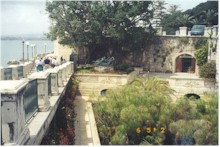 A sunken pond adorned with a bright green shock of papyrus and inhabited
by myriad white ducks, it offers one of several opportunities here to actually
see Greek mythology incarnate. This particular legend was that the river god
Alpheus mercilessly courted a nymph named Arethusa, who lived in the
Peloponnesian Mountains. To escape his ardor she jumped into the sea, but
Artemis saved her and transformed her into the source of a stream, which flowed
to Ortygia and gathered in this spot before emptying into the bay. Surrounded by
sea walls and a host of pleasant outdoor cafes, the pond is now a favorite
hangout of the local youth. There is so much history here.
A sunken pond adorned with a bright green shock of papyrus and inhabited
by myriad white ducks, it offers one of several opportunities here to actually
see Greek mythology incarnate. This particular legend was that the river god
Alpheus mercilessly courted a nymph named Arethusa, who lived in the
Peloponnesian Mountains. To escape his ardor she jumped into the sea, but
Artemis saved her and transformed her into the source of a stream, which flowed
to Ortygia and gathered in this spot before emptying into the bay. Surrounded by
sea walls and a host of pleasant outdoor cafes, the pond is now a favorite
hangout of the local youth. There is so much history here.
We had a wonderful lunch on the roof top restaurant at the Grand Bretagne Hotel. The views of the perfectly round harbor were breath taking. On the way back to the bus we observed the local canoe water polo team practice in the harbor.
We also visited the Sanctuary of the Weeping Madonna of Syracuse on the way back. The church dedicated to her is in the shape of a teardrop. On November 6, 1994, Pope John Paul II visited this sanctuary and gave a sermon on the meaning of the Blessed Mother's tears.
We made it back
to the ship in time for our sailing at 6:00 pm
for Salerno and the Amalphi Coast. Captain Corsaro is from Catania and had not
been home for 3 years. He was able to visit his sick mother for a few hours and
he sailed past her house and blew the horn 3 times. It must have awakened the
entire village. The Captain ordered
a sail away party on pool deck for
the occasion.
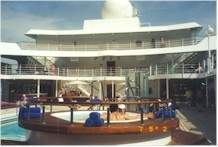 We
were all out there on deck, enjoying the
Jacuzzi, munching on hors d’oevres and drinking champagne, again. This
time, we did not see eruptions from Mt. Etna as we pulled away. It was still
light out, but she was puffing smoke, a sign
that all is well.
We
were all out there on deck, enjoying the
Jacuzzi, munching on hors d’oevres and drinking champagne, again. This
time, we did not see eruptions from Mt. Etna as we pulled away. It was still
light out, but she was puffing smoke, a sign
that all is well.
This evening, we
were dining with Tom Ogg. We had such a great time and lively discussion that we
missed a great show in the Viennese Lounge by the Jean Ann Ryan Production Team,
called Sussurro.
As we left the dining room it was time for the Stromboli show. Stromboli is one of the Aeolian Islands of Italy. The island is about 3 miles (2 km) in diameter and 2,900 feet (900 m) above sea level. It rises 10,000 feet (3,000 m) above the floor of the Tyrrhenian Sea. Stromboli is one of the most active volcanoes on Earth. This time, she did not disappoint. The volcano kept spewing rocks and lava high up in the air every 5-10 minutes for as long as we hang around.
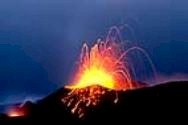 Stromboli
typical eruption.
Stromboli
typical eruption.
It was fun to see, especially since the time we went by her last October was the only day in 5,000 years that she did not erupt. Violent eruptions are rare at Stromboli. Most eruptions at Stromboli consist of small gas explosions that hurl incandescent blobs of lava above the crater rim. Several explosions occur each hour. Larger eruptions and lava flows are less frequent. When this type of eruption is observed at other volcanoes it is often referred to as a Strombolian eruption. This was a great ending to a very busy day full of activities. Sleep came quickly. Tomorrow is another busy day exploring.
May
7, Tuesday
|
Salerno, Italy 8:00 am – 6:00 pm |
Salerno
is situated at the northern end of the Gulf of Salerno. The old town, rising up
the slopes of the hill on the site of the ancient Salernum, still bears evidence
of its great days during the medieval period. 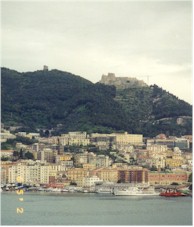 It
had the oldest medical school in Europe, which flourished from the 11th century
until it was closed down by Napoleon's brother-in-law, Murat, in 1812. Today,
Salerno's main attraction is an imposing Romanesque cathedral, built in 1085 and
remodeled in the late 18th century. A flight of steps leads up to an atrium with
28 columns from Paestum and fourteen ancient sarcophagi. The magnificent bronze
doors were made in Constantinople in 1099. Inside you will find the ornate tomb
of Margaret of Anjou and the tomb of Pope Gregory VII, who died in Salerno in
1085. In the richly decorated crypt under the alter lies the remains of the
Evangelist Matthew, brought here from Paestum. A 45-minute walk from the
cathedral leads to a hilltop crowned by the old Lombard Castello, from where
extensive views are available. Along the seafront, to the east of the harbor,
extends a fine promenade lined with impressive modern buildings. The Corso
Giuseppe Garibaldi is the town's principal traffic artery. Travelers coming to
Salerno mainly use the port as a starting point for visits to the Greek temples
of Paestum. Other favorite excursions from here are to Pompeii and to visit the
popular resort towns of Amalfi and Ravello. We
visited Pompeii last October when our cruise ship anchored off of Sorrento. At
that time we also took the ferry over to Capri, but did not have enough time to
make the drive along the famous Amalfi Coast.
It
had the oldest medical school in Europe, which flourished from the 11th century
until it was closed down by Napoleon's brother-in-law, Murat, in 1812. Today,
Salerno's main attraction is an imposing Romanesque cathedral, built in 1085 and
remodeled in the late 18th century. A flight of steps leads up to an atrium with
28 columns from Paestum and fourteen ancient sarcophagi. The magnificent bronze
doors were made in Constantinople in 1099. Inside you will find the ornate tomb
of Margaret of Anjou and the tomb of Pope Gregory VII, who died in Salerno in
1085. In the richly decorated crypt under the alter lies the remains of the
Evangelist Matthew, brought here from Paestum. A 45-minute walk from the
cathedral leads to a hilltop crowned by the old Lombard Castello, from where
extensive views are available. Along the seafront, to the east of the harbor,
extends a fine promenade lined with impressive modern buildings. The Corso
Giuseppe Garibaldi is the town's principal traffic artery. Travelers coming to
Salerno mainly use the port as a starting point for visits to the Greek temples
of Paestum. Other favorite excursions from here are to Pompeii and to visit the
popular resort towns of Amalfi and Ravello. We
visited Pompeii last October when our cruise ship anchored off of Sorrento. At
that time we also took the ferry over to Capri, but did not have enough time to
make the drive along the famous Amalfi Coast.
Shore
Excursions:
Ravello & Amalfi. Sightseeing at Ravello and Amalfi requires a good amount of walking. Price is based on keeping groups small for the walking part of the tour. 6 hours.
This is a
beautiful drive that we always wanted to experience, but not driving it
ourselves. It’s best done on a small tour bus. 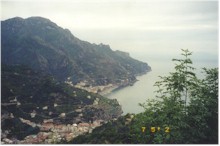 Our
guide was young and inexperienced and spoke poor English. This was a
disappointment. However, the views were magnificent, so how could we complain.
She tried very hard. Some people were
unhappy, however and complained to Silversea. Driving north, the village
of Vietri Sul Mar lies right next to Salerno. This is where the famous Amalfi
Coast ceramic factories are located. Every church tower in the area has a
beautifully decorated ceramic roof. Driving along the winding roads of the
Amalfi Coast sounds like a fairy tale as we passed little villages with names
like Torre de la Marina di Albori, Punta e Lanterna Fuente, Cetara, Erchie, and
around the bend at Capo d’Orso lies the Belvere from where we could see the
island of Capri. Driving along, we pass Maiori and Minori, both villages hanging
onto the cliff side. The Amalfi Coast is truly breathtakingly beautiful. For
centuries poets have sung its praises while artists, inspired by its stunning
coastal scenery, have captured its golden light, dark blue waters and timeless
mountain villages.
Our
guide was young and inexperienced and spoke poor English. This was a
disappointment. However, the views were magnificent, so how could we complain.
She tried very hard. Some people were
unhappy, however and complained to Silversea. Driving north, the village
of Vietri Sul Mar lies right next to Salerno. This is where the famous Amalfi
Coast ceramic factories are located. Every church tower in the area has a
beautifully decorated ceramic roof. Driving along the winding roads of the
Amalfi Coast sounds like a fairy tale as we passed little villages with names
like Torre de la Marina di Albori, Punta e Lanterna Fuente, Cetara, Erchie, and
around the bend at Capo d’Orso lies the Belvere from where we could see the
island of Capri. Driving along, we pass Maiori and Minori, both villages hanging
onto the cliff side. The Amalfi Coast is truly breathtakingly beautiful. For
centuries poets have sung its praises while artists, inspired by its stunning
coastal scenery, have captured its golden light, dark blue waters and timeless
mountain villages.
At Atrani, we turn up the 5 km. narrow winding road that leads to Ravello. I’m sure glad that I wasn’t driving! Cars had to back up around very steep hairpin curves to let us pass. I have to say NO THANKS to driving here.
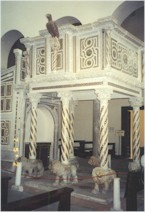
 We
drove back down the 5 km to Atrani and continued to Amalfi.
We
drove back down the 5 km to Atrani and continued to Amalfi.
Amalfi
has always been the capital of the Divine Coast, its origin is part of the
legend, perhaps Roman or Greek, or chosen by Hercules himself for his beloved
nymph Amalfi, as her last home because the color of her eyes and the sea were
exactly alike. 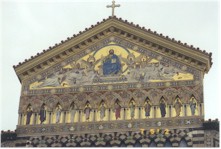
 The
marvelous Cathedral and its Duomo tower are devoted to St. Andrea. Returning
from Amalfi to Salerno was just as exciting. It looks different going the other
way. The views are so marvelous I cannot ever get enough. Every curve is
exciting. The driver took us on a sightseeing tour of Salerno before dropping us
off at the ship.
The
marvelous Cathedral and its Duomo tower are devoted to St. Andrea. Returning
from Amalfi to Salerno was just as exciting. It looks different going the other
way. The views are so marvelous I cannot ever get enough. Every curve is
exciting. The driver took us on a sightseeing tour of Salerno before dropping us
off at the ship.
We departed at 6:00
pm and cruised up the Amalfi Coast all the way past Positano, almost to
Sorrento. It was difficult to get ready for tonight’s dinner. Fortunately, we
had the coast on our side, so that helped. I could sit on the veranda and dry my
hair, etc. Then we headed over to Capri. Vesuvius was looming in the background
and the Bay of Naples was very blue. It’s a magnificent part of Italy and the
whole world. We reached Capri at sunset. My oh my!
Life is so good.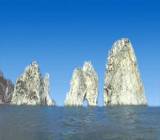 Faraglione
rocks, Capri
Faraglione
rocks, Capri
May
8, Wednesday
|
Rome (Civitavecchia), Italy 8:00 am – 11:00 pm |
Sprawled across
seven legendary hills, romantic and beautiful Rome was one of the great centers
of the ancient world. Although its beginning is shrouded in legend and its
development is full of intrigue and struggle, Rome has always been and remains
the Eternal City. Rome enjoyed its greatest splendor during the 1st and 2nd
centuries when art flourished, monumental works of architecture were erected,
and the mighty Roman legions swept outward, conquering all of Italy. These
victorious armies then swept across the Mediterranean and beyond to conquer most
of the known world. With Rome’s establishment as capital of the western world,
a new ascent to glory began. Today’s Rome, with its splendid churches, ancient
monuments and palaces, spacious parks, tree-lined boulevards, fountains, outdoor
cafés and elegant shops, is one of the world’s most attractive and exciting
cities. Among the most famous monuments is the Coliseum. 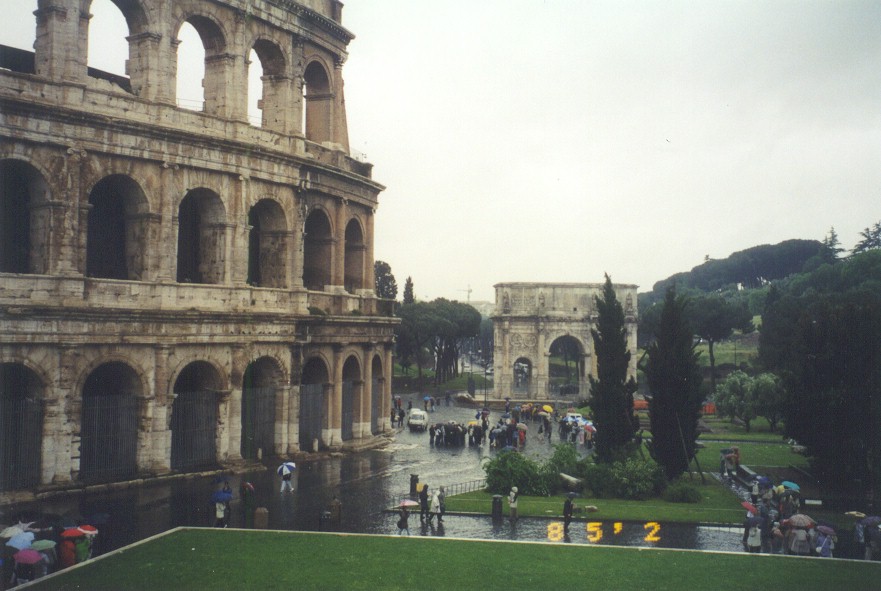
As you walk its
cool, dark passageways, imagine the voices that once filled the arena as 50,000
spectators watched combats between muscled gladiators and ferocious animals.
Stop to see the remains of the Forum, once the city’s political and commercial
center. In later times, Rome’s squares were enhanced with such imposing
structures as the Vittorio Emanuele Monument and grandiose fountains like the
Fontana di Trevi. Join the millions who stand in awe of Christendom’s most
magnificent church and admire the timeless masterpieces of Michelangelo’s
frescoes in the Sistine Chapel. 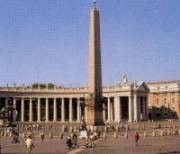
Rome jars the senses and captures the soul. Grasp all you can during the short, precious time you have available in the Eternal City when on a day tour. With so much to see and do, a day or two will only allow you a sampling of the city's marvelous treasures. Big Caution: As in many big cities and tourist destinations purse snatching and pick pocketing is common.
Shore
Excursions:
Rome
- the Eternal city. Guests should be aware that Rome suffers from horrendous
traffic and renovations all the time. When it rains, like today, everyone drives
a car not a scooter, which makes traffic even worse than usual. This causes
frequent traffic jams and obstacles throughout the city. The order of sights may
therefore differ from the one in the tour description. The visit to St.
Peter’s Basilica requires ladies to have their shoulders and knees covered.
Most sites will be seen from the coach, others involve some walking: Piazza
Venezia, The Forum and Colosseum, Trevi Fountain and Borghese Park,
St. Peter's Square, St. Peter's Basilica and Castel Sant’Angelo, 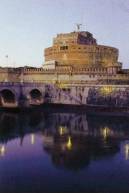 10
hours.
10
hours.
Silversea had arranged for a private visit for a small group to the Vatican Museum in the afternoon. It was a tempting thought, but we choose another great tour.
Nero's Golden House
This
was added in the last minute to our choices of tours and I grabbed it up right
away. It’s very difficult to get tickets, as they only allow small groups at a
time. I read about Nero and his Golden Palace in my Latin classes, so I was
excited to get to see this. The Palace is just a shadow of its former golden
self today. The Domus Aurea was the ultimate in luxury when this crazy house was
built, practically bankrupting the state of Rome. This unique archeological site
of Emperor Nero's Golden Palace reopened in summer 1999 after nearly 20 years of
restoration work and it quickly became one of Rome's most talked about
historical sites. You have to enter with a guide and the tour takes about an
hour.
It’s
all underground, so it’s always chilly inside. 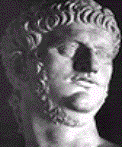 Statue
of Nero.
Statue
of Nero.
The 'Golden House' was built after the fire that destroyed Rome in 64 A.D., as the emperor's ultimate status symbol on the Apian Hill. Its size was an estimated 25 times larger than the Coliseum, whose ruins occupy the space that was Nero's artificial lake.
Inside the palace, Nero is said to have hosted lavish parties in rooms adorned with gold and ivory under ceilings, which dispensed perfume and flowers. One room even rotated. Look for the octagonal room, which is unique.
Little
of that remains today. After Nero's death, subsequent emperors wasted little
time in dismantling the spoils of his excess. In the underground ruins, imprints
of the building's decadence remain in rich but crumbling frescoes and mosaics
that were long forgotten until Raphael and other Renaissance painters went in
and borrowed the style for their work in St. Peter's Basilica and elsewhere. The
Trajans Baths were later built on top of Nero’s House. Before seeing this
impressive site, we toured around Rome by minibus. We drove by St Paul’s
Basilica, Via Ostense, the Pyramid de Cato Cestia, the Aurelian Walls, the Baths
of Caracalla, Circus Maximus, Palatine Hill where Rome was born, the Palaces of
the Ceasars, Theatre of Marcello, and Victor Emmanuel Monument.
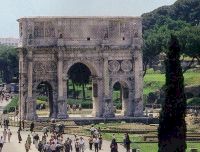 Arch
of Constantine.
Arch
of Constantine.
We
drove Corso Vittorio Manuele to the Vatican and St. Peters, the Castello
D’Angelo, where Emperor Hadrian is buried, Piazza Argentina with the ruins of
its unknown temples is across from where Ceasar was stabbed, Via del Fori
Imperiale to the Forum shops, Colliseum and the Arch of Constantine. Nero’s
Golden House and Gardens is located in this area. After the tour we drove around
some more to Santa Maria Maggiore church, Terme de Diocleziano, Piazza de la
Republica. We were dropped off close to the Spanish Steps and Via Veneto for 2
½ hours on our own.
Even
though it was raining and cool today we enjoyed walking around. We found a
little pizzeria to have a snack lunch. I also found my favorite glove store, so
I needed a few more pairs. As we were walking along I felt a tug on my purse,
which was snug in my shoulder bag. Then I felt it again and turned around to see
what it was. I figured out it was these 2 nice looking French-speaking young
girls with the baby carriage causing a commotion. One of them was pushing the
baby and pretended to be interested in something in a store window. She blocked
the pedestrians with the baby carriage. This way everyone had to slow down to go
around. That’s when the accomplice had a chance to lift wallets or purses. We
followed them around for awhile, which made them very uncomfortable. They would
disappear up the side streets, but we found them and followed them again. I
think I saw one of them showing a wallet to the other and also unload it later
at a storefront. Hold onto your stuff around the Spanish Steps. 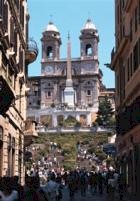 The
police will not help you.
The
police will not help you.
We
drove through Borghese Park, Piazza Popolo, Ponte Mattetotti, and left Rome via
Viale della Milizie. Everyone napped on the way back to the port at
Civitavecchia.
We had another wonderful dinner of seared ostrich appetizer, avocado and tomato gazpacho terrine with asparagus, zucchini creamed soup with saffron, and a choice of grilled whole Dover sole with artichoke, or crisp Long Island duckling in orange sauce, or roasted pork tenderloin in creamed Morel sauce, or braised Kobe beef and a side dish of soba noodles with caviar and chives for the main dish. We made new friends tonight in the dining room.
Tonight was Jazz night in the Panorama Lounge, but we didn’t stay too long. The day’s activities and dinner wines made us very sleepy. We sailed for Livorno and Florence at 11:00 pm.
May
9, Thursday
|
Livorno, Italy 8:00 am – 8:00 am Friday May 10 |
It’s still overcast and raining this morning, which is a big change from the gorgeous weather we were having before getting to Rome, the Italian mainland. Oh well, being from the Pacific Northwest, we can handle it. The weather doesn’t stop us from doing anything.
Livorno is Italy’s second-largest port after Genoa; it also serves as a convenient gateway to the Tuscany region. Venturing into downtown Livorno, be sure to explore the local market and a variety of fine shops. There are plenty of excellent restaurants in this busy commercial city.
Tuscany
is known for its classic landscapes of gently rounded hills with clumps of
slender cypresses and lush vineyards, famous for the dry, dark-red Chianti
wines. Visitors come to see the great art centers of Florence, Lucca and Pisa,
to name but a few.
From
this part of Italy the national language evolved with Dante and other great
Tuscan writers of his period. Even more important is the impact this area had on
the culture of the rest of Italy and all of Europe; the flourishing of the
Renaissance added a vast wealth to the architectural and artistic heritage. The
Italian Renaissance, with its most active center in Florence, lasted from the
1400s to the 1700s. Its greatest support came from the all-powerful Medici, the
multitudes of religious bodies and the guilds, whose merchants laid the
foundation to the city’s prosperity. They commissioned Italy’s most talented
painters, sculptors and architects to create some of the most important works of
art. Names such as Michelangelo, Machiavelli, Giotto, Vasari, Boticelli, da
Vinci, Donatello and Dante come to mind, all of whom worked and lived in
Florence at some time in their life.
We
had a great tour of Florence on a previous visit, so we decided not to opt for
this tour.
Pisa
is known for its brilliant ensemble of monuments, which include the 11th-century
Cathedral, the Baptistery and the Bell Tower with its pillared galleries. The
tower achieved additional fame because of its tilt, having been built on
unstable, alluvial land. Galileo, who was born in Pisa, made use of the
tower’s inclination in his experiments on the law of gravity. Over the years,
successions of architects have attempted to correct the tilt, which by now
measures over 15 feet.
We
decided on the tour to Lucca and were hoping to get to see Pisa on the way. We
did see it, but only from the highway. Because of the very heavy traffic on
these narrow country roads and regulations for tour busses, it would take too
much time to make a stop here. At least we know it’s there.
Our
shore excursion is
Lucca & Lucchese Villas.
Sightseeing in Lucca is entirely on foot. We recommend wearing comfortable
walking shoes. Price is based on keeping groups small for the guided walk: Lucca,
Piazza di San Michele, Casa di Puccini, Basilica of San Frediano, Piazza
Anfiteatro, Villa Visit, 8.5 hours. Lunch included.
Lavinia
is our excellent guide to Lucca today. She knows everything about Tuscany.
Our
first stop after one hour’s drive is the Villa Torrigiani in Camigliano,
Lucca. It’s one of 13 villas owned by
the same family, made wealthy by the silk trade. Villa Torrigiani is
situated on the lovely hills surrounding the town of Lucca.
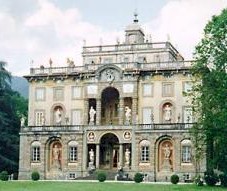 .
In its garden there are many ponds and many beautiful trees. The villa and the
park date back the beginning of the 16th century. The owners then were the
powerful Buonvisi family. It was the meeting place between Marquise Lucrezia,
the wife of Lelio Buonvisi, and her lover (Arnolfini) who seems to have been
captured right in front of the gates of Camigliano, having been accused of the
assassination of Marquis Lelio, which had taken place in the city. During the
first half of the 17th Century Villa di Camigliano was purchased by Marquis
Nicolao Santini, the ambassador of the Republic of Lucca to the court of Louis
14th (the sun King), who wanted to transform it into a sumptuous dwelling, with
a garden of flowering parterres and grand basins, into which the facade would
reflect. The garden was to be built according to the plans done by Le Notre for
the royal home of Versailles. The villa now has a baroque facade. The stairs in
the garden are called "di Flora". The Grotto of the Winds has 17th
century statutes. The water works exist according to the 17th-century, original
system. There is a one-km long Valley of Cypresses. These trees are over one
hundred years old. It was raining hard at this point and the trail was a bit
muddy. We entered the villa from the back of the garden. As we enter into the
villa there are decorations of frescoes by Pietro Scorzini on the walls. They
have been perfectly conserved and show the seasons in the bedrooms, mythological
scenes in the sitting rooms and Emperor Aureliano in the main drawing room: all
of which creates a frame for the original furniture which is still there.
.
In its garden there are many ponds and many beautiful trees. The villa and the
park date back the beginning of the 16th century. The owners then were the
powerful Buonvisi family. It was the meeting place between Marquise Lucrezia,
the wife of Lelio Buonvisi, and her lover (Arnolfini) who seems to have been
captured right in front of the gates of Camigliano, having been accused of the
assassination of Marquis Lelio, which had taken place in the city. During the
first half of the 17th Century Villa di Camigliano was purchased by Marquis
Nicolao Santini, the ambassador of the Republic of Lucca to the court of Louis
14th (the sun King), who wanted to transform it into a sumptuous dwelling, with
a garden of flowering parterres and grand basins, into which the facade would
reflect. The garden was to be built according to the plans done by Le Notre for
the royal home of Versailles. The villa now has a baroque facade. The stairs in
the garden are called "di Flora". The Grotto of the Winds has 17th
century statutes. The water works exist according to the 17th-century, original
system. There is a one-km long Valley of Cypresses. These trees are over one
hundred years old. It was raining hard at this point and the trail was a bit
muddy. We entered the villa from the back of the garden. As we enter into the
villa there are decorations of frescoes by Pietro Scorzini on the walls. They
have been perfectly conserved and show the seasons in the bedrooms, mythological
scenes in the sitting rooms and Emperor Aureliano in the main drawing room: all
of which creates a frame for the original furniture which is still there.
It’s raining
pretty hard and we were glad to get back on the bus for the drive to Lucca,
the provincial capital of Tuscany, is one of the most handsome Romanesque cities
in Europe. 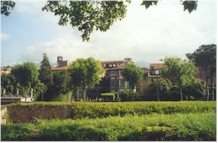 Lucca
is one of the most ancient towns of Etruria with its rich cultural and
mercantile heritage and boasts a unique town center. It
is especially known for its medieval ramparts, which date back to the
15th century, allowing one to walk, jog
or bike around the whole circuit.
Lucca
is one of the most ancient towns of Etruria with its rich cultural and
mercantile heritage and boasts a unique town center. It
is especially known for its medieval ramparts, which date back to the
15th century, allowing one to walk, jog
or bike around the whole circuit.
Just
as interesting is its historic center featuring several fine old churches and
lovely squares. Lucca is also known as the home of composer Giacomo Puccini,
whose birthplace is now a museum. A walking tour of the historic center, some
shopping in its elegant stores and a meal of the renowned Tuscan cuisine are
considered among the highlights of a visit to this area. Before an absolutely
delicious lunch at Boca de St Antonio Restaurant on Piazza de Cocomeri, we
walked around a little on our own. We discovered that Lucca has many churches, I
was told 99 of them and a cathedral that all look pretty much alike at first
glance, and we managed to get lost and were late for lunch, which was
embarrassing. One of the oldest restaurants in Lucca, the Buca takes its name
from the old Tuscan word for inn, and was once a staging post for horses. The
restaurant is now one of the best known in the Lucca area for its antique rustic
ambience, meticulous service and the fine standard of cooking based very much on
local tradition. The lunch was absolutely great, 5 dishes were served along with
wine, coffee and dessert.
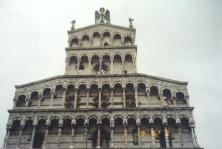
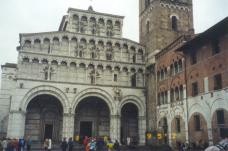
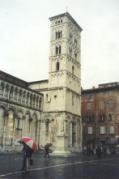
Church of San Michele de Foro Duomo di San Martino
After lunch, we visited Puccini’s home, Casa di Puccini, just off Piazza San Michele, on Via di Poggio. This is the house where Giacomo Puccini was born in 1858. Now a small museum with portraits, scores, sketches and the Steinway piano at which Lucca's most famous son composed Turandot.
Our walking tour
included a visit to the remarkable Piazza Anfiteatro, a circuit of medieval
buildings whose foundations are the arches of the Roman amphitheatre. Just
southeast, the strangest sight in Lucca is perhaps the tower of Casa Guinigi,
the fifteenth-century home of Lucca's leading family, with a battlemented tower
surmounted by Holm oaks whose roots have grown into the room below. From Via San
Andrea you can climb it for one of the best views of the city. One
of the most charming characteristics of Lucca is its gardens. Most of the
ancient houses have quadrangle courtyards. The sun came out and warmed us up as
we walked the ramparts and enjoyed a terrific view of this walled in medieval
city.
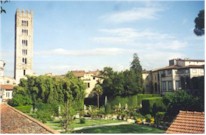
View from the ramparts.
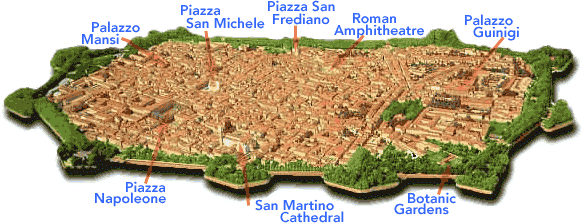
It was a wonderful day in the Tuscan countryside. We arrived back at the ship in time for cocktails and dinner of roasted Australian lamb rack with tomato eggplant cake, a Silversea Signature dish. You can’t go wrong with anything on the menu. If nothing appeals, you can order anything else you want, most of the time it’s no problem at all. Caviar is always available as an appetizer, even when it’s not listed on the menu.
After dinner, we attended the wonderful concert Corale Pietro Mascagni: evening songs by Puccini and Verdi, featuring mezzo-soprano Gloria Parker and John Paul Almon.
Other Shore
Excursions that were offered:
1.
Splendors of
Florence.
The drive to Florence is two hours each way. Sightseeing in Florence is entirely
on foot. Comfortable shoes are essential. For the comfort of tour guests, the
price is based on small groups for the walking part of the tour. Leisure time in
Florence may have to be limited due to time constraints. Reminder: Keep an eye
on your wallet and purse at all times. Do not wear valuable jewelry or carry
large amounts of cash. Be careful in the area around the Accademia, where beggar
women and children have been known to pick visitors' pockets: The Accademia, The
Duomo, The Battistero, The Campanile, Piazza della Signoria, Church of Santa
Croce, 9 hours.
2.
A day in Tuscany.
Tour involves a considerable amount of driving through winding country roads and
along the motorway. Sightseeing in the towns is on foot. Price is based on
keeping the groups small for the walking part of the tour. A minimum is required
for the tour to operate: Impruneta, Greve, Vicchiomaggio Castle, 9 hours.
3.
Medieval Siena.
Guests must be aware that sightseeing in hilly Siena is entirely on foot and
requires a great amount of walking. Tour is subject to minimum participation.
Price is based on keeping the groups small for the walking part of the tour:
Piazza del Campo, Piazza del Duomo, Guido Restaurant, San Miniato, 10.5 hours.
4.
Monuments of
Pisa.
Tour involves a considerable amount of walking. Price is based on keeping groups
small for the walking part of the tour: Campo dei Miracoli, Pisa, 4 hours.
5.
Florence on your
own:
This is strictly a coach transfer to and from Florence, subject to minimum
participation. It does not include any guided sightseeing, admission fees or
lunch in Florence. The drive is about two hours each way. 10 hours.
May
10, Friday 8:00 am
|
Depart Livorno, Italy, cruising the Mediterranean Sea |
We left Livorno at 11:00 pm instead of the following morning as originally planned for some reason Captain Corsaro explained to us. Therefore, he promised us a surprise in the morning. It turned out to be a close to shore cruise by Monte Carlo, where Silversea Cruise Line was born and where Captain Corsaro took the helm of the first Silversea ship, the Silver Cloud in April 1994. Ray Solaire, the Cruise Director also was onboard on that very first cruise. We also cruise close by Nice and Cannes before heading off towards Barcelona. Unfortunately, the weather had not improved and it was cool, windy, and rainy all day. This was the first time we had breakfast in the dining room. We always had ordered room service the night before as a wakeup call as much as a convenience. Our shore excursions always left early in the morning. On nice days, we prefer to sit outside on the aft deck and pick breakfast items from the buffet in the Terrace Café. That to me is cruising. Ditto for lunch.
Dr. Galler’s talk today is about “European Unity: From the Treaty of Rome to the Euro”. He’s such an interesting speaker I can’t miss this. Here’s another joke: Why does Bin Laden always carry camel dung in his pocket? (In case he needs a picture ID). Good one!
We met the NACTA group in the bar for a last farewell and business card exchange. Then we had a “date” with Ken and April from Silversea, who wanted to show us the suites. The Vista suites at 287 square feet are like the Veranda suites, 345 square feet, but without the veranda. These are so spacious and will be adequate for anyone. There are 2 Medallion suites at 521 square feet and 13 Silver suites at 701 square feet. These always sell out first, according to Ken. It looks very comfortable and I love the way the bed faces the veranda, so you can lie in bed and see the sea. The Silver Suites feature separate dining and living rooms that is perfect for gatherings with friends. These suites offer larger verandas that are a perfect hideaway for guests who want a private place in the sun.
Stepping into the Owner's Suite I felt as though I entered a stylish apartment along the shores of the Italian Riviera, which really is how it started on the Silver Cloud. It turned out guests wanted to buy the Owners suite, so the Silver Whisper has 2 of them that can connect to a Veranda Suite. At 1,208 square-feet, these suites are decorated in hushed pastels and warm hues, all of which were personally selected by the ship's owner. The suites feature a 200-square foot teak veranda with floor-to-ceiling sliding glass doors and patio furniture and two bedrooms with ocean views. The 2 Royal Suites are incredible at 1312 feet. They are located at the bow of the ship on deck 6 and 7. Both can connect to a Veranda Suite. There are also 2 Grand Suites, # 601 is 1409 square feet and # 701 is 1435 square feet. Needless to say these are much more elegant than most people’s homes.
I walked around the entire ship video taping every nook and cranny, since the ship is too beautiful for words.
Today is the Galley lunch extravaganza. We make our way down there as a group. WOW! Where to begin? First, I had to videotape the food displays. This took a long time, as I was totally overwhelmed by the fabulous way it was displayed. There were the salads, the breads, the veggies, and the cold seafood of 5 kinds of shrimp, stone crabs, lobster, and crayfish. This is my favorite food. There were many other cold fish selections, and the meats, Oh MY! The pasta, oh! Is made fresh every day. The best pasta I’ve ever had is on this ship. Then there are the hot dishes, how am I going to do this? It’s incredible. Did I mention the desserts? Sinful is the only word that comes to mind. After lunch, it’s naptime. And we have to pack too, that’s no fun. This cruise went way too quickly. I could live on this ship.
Tonight is the Captain’s farewell reception in the Viennese Lounge. Captain Corsaro is a very “comfortable” person to be around. He genuinely seems to enjoy mingling with the passengers and answer all questions. He runs a very smooth ship and everyone seem happy to be working under him. He’s always smiling. After some dancing and champagne, we head up to the Le Champagne because we’re having dinner at the Terrace Café tonight. The theme is “Secrets of the Sea”, featured by Chef Norbert Ruhrdorfer. For starters we get Stuffed Potato Caviar, followed by Grilled Chilean Seabass and Asparagus Salad with Morel Vinaigrette. The soup is of Scallops and Prawns, Curry and Coconut with Lemongrass flavor. To cleanse the palate, a refreshing Vodka Lime Sorbet is offered. The main course is Surf and Turf My Way: Roasted Lobster Tail with Tarragon Mousseline Sauce and Grilled Beef Tenderloin with Sauce Choron. The fabulous dessert that I thought there is no way I can make room for it was incredible: Icing Nougat with Candied Fruit and Raspberry Coulis, Petit Fours and Chocolate Truffles.
As you may have noticed by now, Fine Dining is a big part of a Silversea cruise. I never once ever heard anyone complain about any food or it’s preparation.
May
11, Saturday 8:00 am
|
Barcelona, Spain:
Disembark. NH
Calderón Hotel |
We arrived early in the morning in Barcelona and had breakfast in the dining room before saying goodbye to the Silver Whisper and her crew. We took a cab with Jan and Don to the hotel.
Hotel Calderon
is located one block north of the Plaza de Cataluña in the heart of the
commercial and business district of Barcelona, a great location for exploring
all the great sights and within easy walking distance to La Rambla. The hotel
has 224 rooms and 29 suites with direct-dial telephone, color TV, pay-per-view
movies and video games, Canal Plus, mini-bar, air conditioning, free toiletry
kit, hair dryer, piped music, a choice of pillows (firm, soft, etc.), buffet
breakfast, special breakfast for early risers and room service. Restaurant, 9
meeting rooms, cocktail bar, laundry and valet service, gymnasium, sauna,
outdoor pool, indoor pool and sun deck. But it’s pouring “cats and dogs”
today, so we didn’t look at the pool. 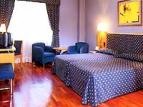 Our
room at Calderon.
Our
room at Calderon.  Tourist
bus.
Tourist
bus.
We left our bags with the bellboy and went exploring. There is a great system of “hop on and off as you wish” sightseeing tourist bus. They operate 2 routes, the red and the blue that follow different routes, stopping at 27 of the most interesting sights. They leave from Plaza de Cataluña every 15 minutes and continue until late at night. There is a fixed price for the day or buy tickets good for 2 days. We got on the blue bus which came first and just rode it all the way around. It was raining hard and we just wanted to get our bearings before checking into our room. The roundtrip takes 2 hours if you don’t get off anywhere. You also receive a coupon book with discounts to all the entrance fees to the museums at every stop.
The blue route
travels north up Passeig de Gracia with a stop for La Pedrera, an apartment
house built by Gaudi. 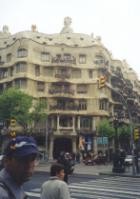 La
Pedrera. This is the year celebrating his 150th
birthday, so Gaudi is featured prominently in Barcelona this summer. The bus
then travels down Av. Diagonal, turns on Av Josep Tarradellas with stops at
Estacio de Sants, the main railroad station, and Placa Espanya, gateway to the
trade fare site and Montjuic. The
two Venetian towers, which flank the Avenida Maria Cristina, mark the entrance
of the trade-fair site, which is overlooked by the majestic Palau Nacional, home
to the Museu Nacional d'Art de Catalunya. Next stop is Poble Espanyol,
built for the 1929 International Exhibition. The following stop is at Anella
Olimpica, site of the opening and closing ceremonies at the 1992 Olympic games,
and the the Museu
Nacional d'Art de Catalunya (MNAC) boasts one of the best views of the city,
with the trade-fair pavilions and the magic fountain in the foreground. The
museum houses the world's most important collection of Romanesque art. The
next stop is for the Teleferic de Montjuic with panoramic views, on a nice day
that is, and the Fundacio de Joan Miro and the Contemporary Art Center dedicated
to his art. Next stop is at Miramar Gardens where cactus and palm trees overlook
the sea from the mountain. It’s really pouring down rain, so it’s no point
in trying to see anything here. We continue on to Colon and La Rambla, where we
see the Silver Whisper. 3 couples seated next to us are getting on her this
afternoon and of course we start talking about our experience. They are eager to
find out everything. Seems one guy doesn’t think he likes to cruise, and was
talked into going along. He hates waiting in line and envisioned a Carnival
Cruise type experience. He felt a lot better after talking to us and found out
what to expect. He started looking forward to boarding the ship. We rode around
the port, past the zoo and the Ribera District while talking about the cruise.
Soon we found ourselves back at Cataluna square. We walked back to the hotel.
La
Pedrera. This is the year celebrating his 150th
birthday, so Gaudi is featured prominently in Barcelona this summer. The bus
then travels down Av. Diagonal, turns on Av Josep Tarradellas with stops at
Estacio de Sants, the main railroad station, and Placa Espanya, gateway to the
trade fare site and Montjuic. The
two Venetian towers, which flank the Avenida Maria Cristina, mark the entrance
of the trade-fair site, which is overlooked by the majestic Palau Nacional, home
to the Museu Nacional d'Art de Catalunya. Next stop is Poble Espanyol,
built for the 1929 International Exhibition. The following stop is at Anella
Olimpica, site of the opening and closing ceremonies at the 1992 Olympic games,
and the the Museu
Nacional d'Art de Catalunya (MNAC) boasts one of the best views of the city,
with the trade-fair pavilions and the magic fountain in the foreground. The
museum houses the world's most important collection of Romanesque art. The
next stop is for the Teleferic de Montjuic with panoramic views, on a nice day
that is, and the Fundacio de Joan Miro and the Contemporary Art Center dedicated
to his art. Next stop is at Miramar Gardens where cactus and palm trees overlook
the sea from the mountain. It’s really pouring down rain, so it’s no point
in trying to see anything here. We continue on to Colon and La Rambla, where we
see the Silver Whisper. 3 couples seated next to us are getting on her this
afternoon and of course we start talking about our experience. They are eager to
find out everything. Seems one guy doesn’t think he likes to cruise, and was
talked into going along. He hates waiting in line and envisioned a Carnival
Cruise type experience. He felt a lot better after talking to us and found out
what to expect. He started looking forward to boarding the ship. We rode around
the port, past the zoo and the Ribera District while talking about the cruise.
Soon we found ourselves back at Cataluna square. We walked back to the hotel.
Our room was ready and we checked in.
Barcelona
is the capital of Catalonia and Spain’s second-largest city. It is also one of
the world’s most gracious cities. Dominated by Montjuic, Vallvidrera and the
Tibidabo Hills, sophisticated Barcelona is rich in ancient and modern
architectural and artistic treasures. Many talented artists, sculptors and
architects lived here, including Picasso, Gaudi, Miro and Mares, who found the
warm days and lively nights an inspiration for their art. The Phoenicians
founded the city. As a port it really began to develop under the Romans. The
most significant period was during the Middle Ages when Barcelona's wealth
equaled that of the whole Catalonia province. In the 19th century Barcelona grew
into a major European port. The city developed around its Gothic Quarter. The
splendid buildings from the 13th and 15th centuries and the medieval ambiance
remain major attractions for the thousands of visitors every year.
In
addition to the narrow streets of the Gothic Quarter there are the magnificent
avenues cutting through the modern part of the city. They are lined by elegant
boutiques and the whimsical facades of buildings designed by the famous
Catalonian architect Antonio Gaudi. The city has many outstanding museums
dedicated to such masters as Picasso, Miro and Mares.
No
visit to Barcelona would be complete without seeing the most unique edifice, the
Church of the Holy Family, or Sagrada Familia. Gaudi began this fantastic
creation in 1883 but was unable to finish. Work was restarted in 1940 but has
been greatly hindered because Gaudi left no plans or notes to assist in
completing his masterpiece. The rain is letting up a bit, so we decide to walk
to the Sagrada Familia from the hotel and catch the red bus from there. We pass
La Pedrera on the way.
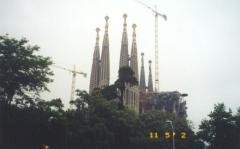
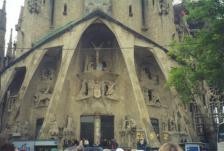
Familia Sagrada.
Here’s a map of the bus routes.
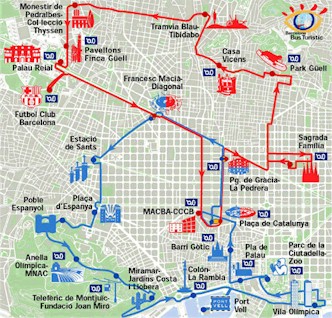
We catch the red
bus and get off at the next stop, Park
Güell, Gaudí's
architecture in garden form, a World Heritage Site, named after Gaudí's great
patron, Count Eusebi Güell.
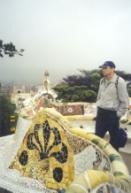
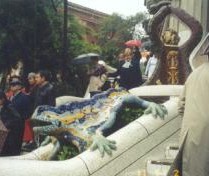
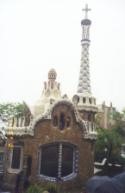
Park Güell.
Although initially planned as a residential garden city in the English style (hence the name "Park"), the initiative was unsuccessful and only one show-house was built and today it houses the museum devoted to the architect.
Gaudí (1852-1926) was born in Reus. From early childhood he was a keen observer of nature, attracted by its shapes, colors and geometry. In 1862 he decided to study architecture in Barcelona, and his first architectural work oscillated between reinterpreting historic canons with an Oriental influence and the recovery of mediaeval elements.
It’s raining
on and off, and we pass by Casa Vicens, which is not open to the public, and Tramvia
Blau – Tibidabo, a romantic
tram ride to Barcelona's great observation deck. We drive right past Monestir
de Pedralbes - Collecció Thyssen, which is closed.
We
decide to get off Pavellons Finca Güell,
the first work commissioned from
Gaudí by his patron Güell. The gates are closed, so we get a picture and catch
the next bus. It’s pouring again. We admired the
imposing dragon gateway, 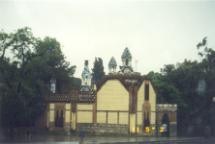 a
genuine wrought-iron sculpture designed by Gaudí.
a
genuine wrought-iron sculpture designed by Gaudí.
We ride by the Royal Palace and gardens in the university district and the Football Club. We drive down Av. Diagonal and turn on Balmes. We get off at the old town and decide to walk down the famous La Rambla. This is a lively promenade of flower merchants and cafes. It meanders from Plaza Cataluya to the Columbus Statue by the port. Halfway is the market, a very interesting visit with its fresh fish and vegetables. Lots of activity here where the locals shop for fresh produce every day.
Back at the
hotel, we hooked up with Jan and Don and the Levis for dinner at a local tapas
bar, just a block away. Chunky
wooden tables and stools and a bar heavy with platters of bite-size delicacies
on tiny slices of bread mean you're in a Basque bar. Aside from the vast array
of pintxos,
they also prepared some mouthwatering cazuelitos
(small earthenware dishes filled with anything from clams to cod to freshwater
crayfish, all prepared with traditional sauces). Yum. And of course, the
pitchers of Sangria were delicious and powerful.
We left early the next morning on BA via London. The flights were uneventful. We arrived to Seattle on time.
